Great Smoky Mountains National Park (93)
Updated: Hatcher Mountain fire nearly extinguished; 300 structures affected
Written by Thomas Fraser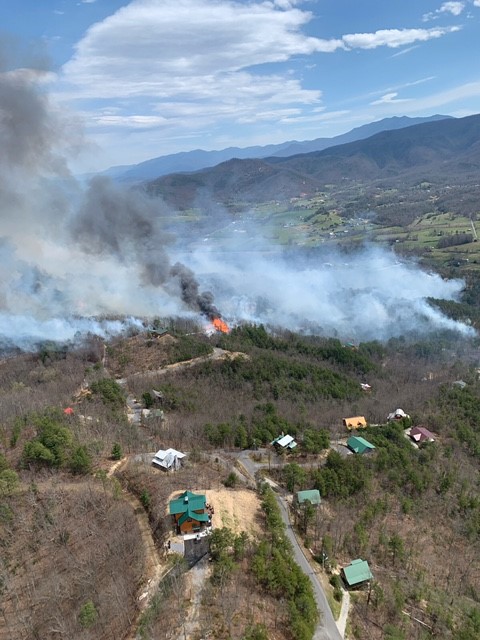 Sevier County Emergency Management Agency
Sevier County Emergency Management Agency
Forest fire above Wears Valley in Sevier County nears full containment; Seymour fire under control
UPDATE APRIL 4: The Sevier County Emergency Management Agency said the Hatcher Mountain/Indigo Lane fire is largely extinguished. Fire crews continue to further subdue the Millstone Gap fire near the Sevier/Blount county line.
The National Weather Service warns of continued high fire danger citing breezy winds and low humidity. Widespread rainfall is forecasted to fall beginning tomorrow.
Officials said the Hatcher Mountain fire ultimately burned 2,500 acres, and damaged or destroyed 300 structures.
UPDATE APRIL 1: Fire crews focusing on the stubborn Hatcher Mountain fire had to pivot in part early Friday to also fight a new wildfire in Seymour near the Blount and Sevier county lines.
Sevier County officials said the Wears Valley-area fire was 45-percent contained this afternoon following a significant brew-up late Thursday. At least 100 structures/dwellings had been “affected” by the fire, which has consumed at least 3,739 acres. Numerous rental cabins and homes have been lost.
Parson Branch Road improvements under way in Smokies
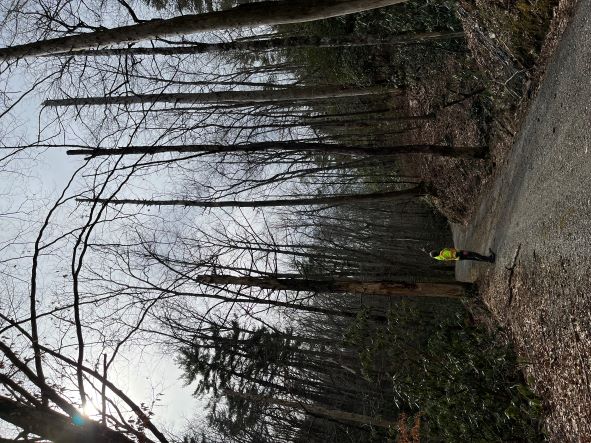 Dead hemlocks are seen along Parson Branch Road near Cades Cove. National Park Service
Dead hemlocks are seen along Parson Branch Road near Cades Cove. National Park Service
CADES COVE — Great Smoky Mountains National Park contractors began removing at least 800 dead hemlock trees along Parson Branch Road, an eight-mile primitive backcountry road that connects Cades Cove with U.S. 129 on the western edge of the park.
The road has been closed since 2016 because of the tree hazards and damage to the road surface. The hemlocks succumbed to the hemlock woolly adelgid, an exotic insect that has wreaked havoc on hemlock stands and their accompanying ecosystems.
The road passes several trailheads, and is used by emergency vehicles as needed. The park initially identified some 1,700 trees that posed a hazard to the adjacent roadway, but that number has naturally declined by about half over the past six years.
Friends of Great Smoky Mountains National Park provided $100,000 for the hazard-mitigation project. That was matched with $50,000 from the federal government.
Once the dead trees are removed, work will begin to rehabilitate the roadway and ensure its safety.
The roadway could reopen this summer, according to a news release from the National Park Service.
$30m comes home to roost for Foothills Parkway rehab project
Written by Thomas Fraser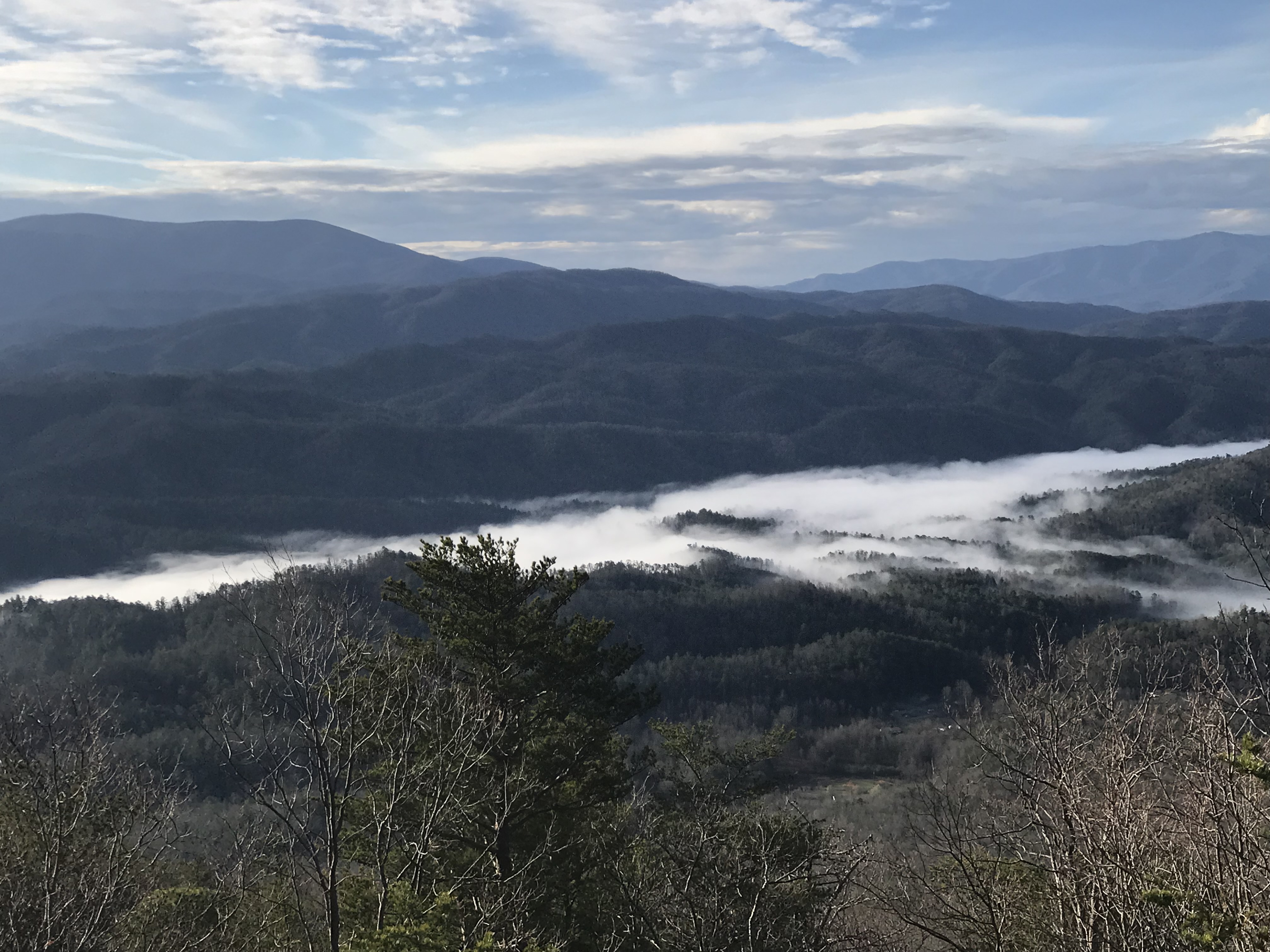 A view of the Smokies from the southern section of Foothills Parkway. Thomas Fraser/Hellbender Press
A view of the Smokies from the southern section of Foothills Parkway. Thomas Fraser/Hellbender Press
Hellbender told ya so: Big money in hand for southern Foothills Parkway rehab
Hellbender Press reported some particulars months ago, but the National Park Service today announced the official receipt of $30 million dollars for rehabilitation of the southern section of Foothills Parkway between Calderwood and Walland.
It’s been a busy news week out of Great Smoky Mountains National Park, especially related to the Foothills Parkway: Earlier this week the park service announced the latest phase of comment on plans to establish a series of mountain bike trails in Wears Cove at the terminus of that parkway section. Hellbender covered that, too.
Maybe too much Smokies, if that’s a thing, but we felt obligated to report via a park press release the final dispersal of funds for the planned improvements we reported on months ago. Significant traffic closures will likely begin this spring.
National Park Service pedals toward construction of mountain-bike trails and concessions in Wears Cove
Written by Thomas Fraser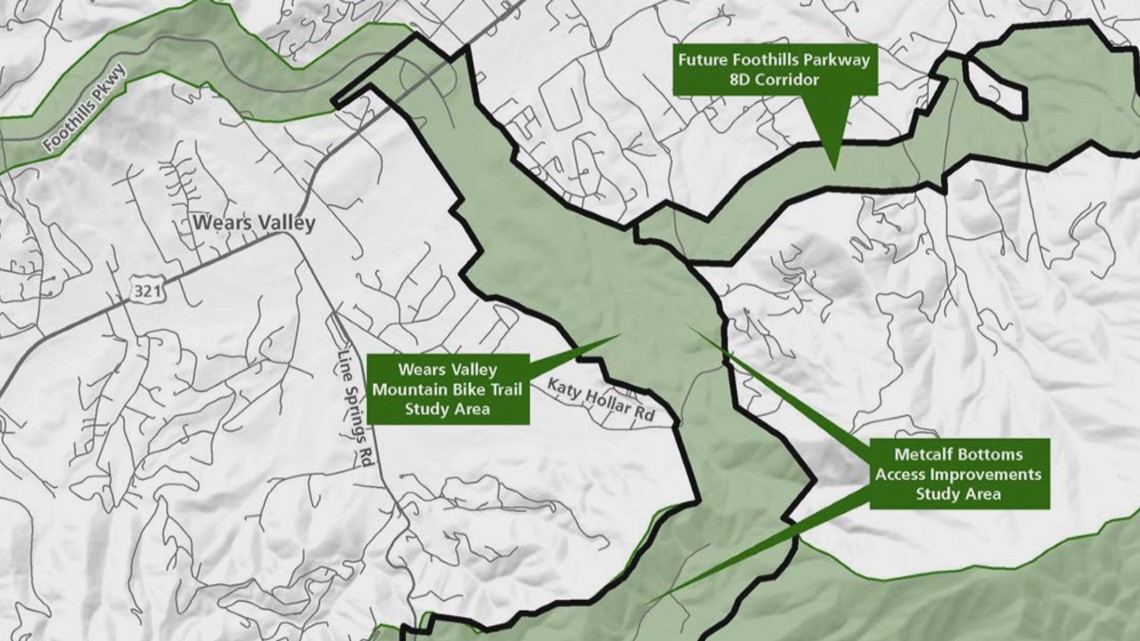 National Park Service via WBIR
National Park Service via WBIR
Feds and boosters have considered trail network since completion of the “Missing Link”
WEARS VALLEY The National Park Service moved this week into the latest public-input phase regarding proposed construction of a Smokies-area mountain-biking destination on federal land near the current terminus of a recently completed section of Foothills Parkway that runs from Walland to Wears Valley.
The plan calls for miles of single-track mountain bike trails of varying skill levels and vendors catering to bicyclists. Park service documents indicate a rest station with picnic facilities, bathrooms and bicycle rental and repair facilities sited in Wears Cove southeast of the parkway terminus at Wears Cove. The parcel is already part of a federal easement for another extension of the parkway that would connect with the Gatlinburg Spur.
“The Wears Valley portion of the Foothills Parkway could provide visitors new opportunities to experience the Park through mountain biking because it is within the Park’s general development zone and transportation management zone and is not managed as wilderness,” according to park service documents.
- wears valley mountain biking proposal
- foothills parkway
- foothills parkway extension
- walland to wears valley foothills parkway
- environmental assessment
- nepa national environmental policy act
- mountain bike park
- karst
- public comment
- public input
- decision making
- mountain bike trail
- planning
- trail system
Outgoing Smokies forester Kristine Johnson leaves behind a legacy of science and communication
 Appalachian Voices
Appalachian Voices
Citizen Times: Smokies forester bids adieu to her arboreal home
Good read here from the Asheville newspaper about the retirement of Great Smoky Mountains National Park Supervisory Forester Kristine Johnson.
In her three decades at the Smokies, she has tackled issues ranging from exotic and invasive plants to the slow and disastrous demise of the park’s hemlocks due to the hemlock wooly adelgid.
“‘The work we do includes forest health in all aspects,’ said Johnson, who is retiring this month after more than 30 years in the Smokies,” Frances Ligart reported. “Her career has been devoted to reducing the introduction into the park of exotic plants, insects, and diseases.”
Updated 8/14: Plans for Foothills Parkway extension from Wears Valley to Gatlinburg enter newest public input phase
Written by Thomas Fraser and Rick Vaughan
Critics have called for full Environmental Impact Statement amid threat to Southern Appalachian habitats; previous draft EIS identifies many rare, notable species in project right of way
GATLINBURG — Proposed construction of an unfinished section of Foothills Parkway from Wears Valley to the Gatlinburg Spur would traverse 9.8 miles of natural beauty that is home to multiple rare species identified in a 1994 study.
The federal government last month opened the latest round of public comment on the project, which would traverse Buckeye Knob and Cove Mountain and multiple aquatic and karst environments. Concerns raised by the public over the decades range from impacts on domestic water supplies and endangered or threatened species to the fact the roadway might be a catalyst for excessive tourism infrastructure in Townsend and Wears Valley.
The proposed route also extends through dense areas of pyrite, a highly acidic sulfate mineral (also known as fool’s gold) that can poison entire watersheds when exposed if proper erosion controls aren’t followed. Contamination of streams and creeks led to the decades-long delay in full construction of the existing parkway section (known as the missing link) that extends from Walland to Wears Valley.
- foothills parkway extension
- opposition to foothills parkway extension
- smokies foothills parkway
- nepa
- endangered species foothills parkway
- fhwa federal highway administration
- ea environmental assessment
- nepa national environmental policy act
- nhpa national historic preservation act
- national parks conservation association
- pyrite
- jeff hunter
- missing link of foothills parkway
Feds reopen plans for long-delayed 9-mile Foothills Parkway segment from Wears Valley to Gatlinburg near Great Smoky Mountains National Park
Written by Thomas Fraser
Plans for new parkway segment were hatched long ago; project would also include improvements to Wears Valley park entrance
Just a few years after the “Missing Link” of the Foothills Parkway was finally finished following decades-long delays, the National Park Service now has its sights set on constructing a new 10-mile section of parkway on the Tennessee side of Great Smoky Mountains National Park that would extend from Wears Valley to the heavily traveled Gatlinburg Spur.
The leg of the roadway has long been included in a plan for full completion of the parkway. About 30 miles have been completed from Tallassee, Tennessee to Wears Valley. This section would extend from the current parkway terminus in Wears Valley to the Gatlinburg Spur near Pigeon Forge.
Park officials said in a press release announcing the opening of the project’s public comment period that the unfinished section is the only stretch of incomplete, congressionally approved roadway in the U.S.
Tragedy of the commons: Plant poaching persists in Smokies and other public lands
Written by Ben Pounds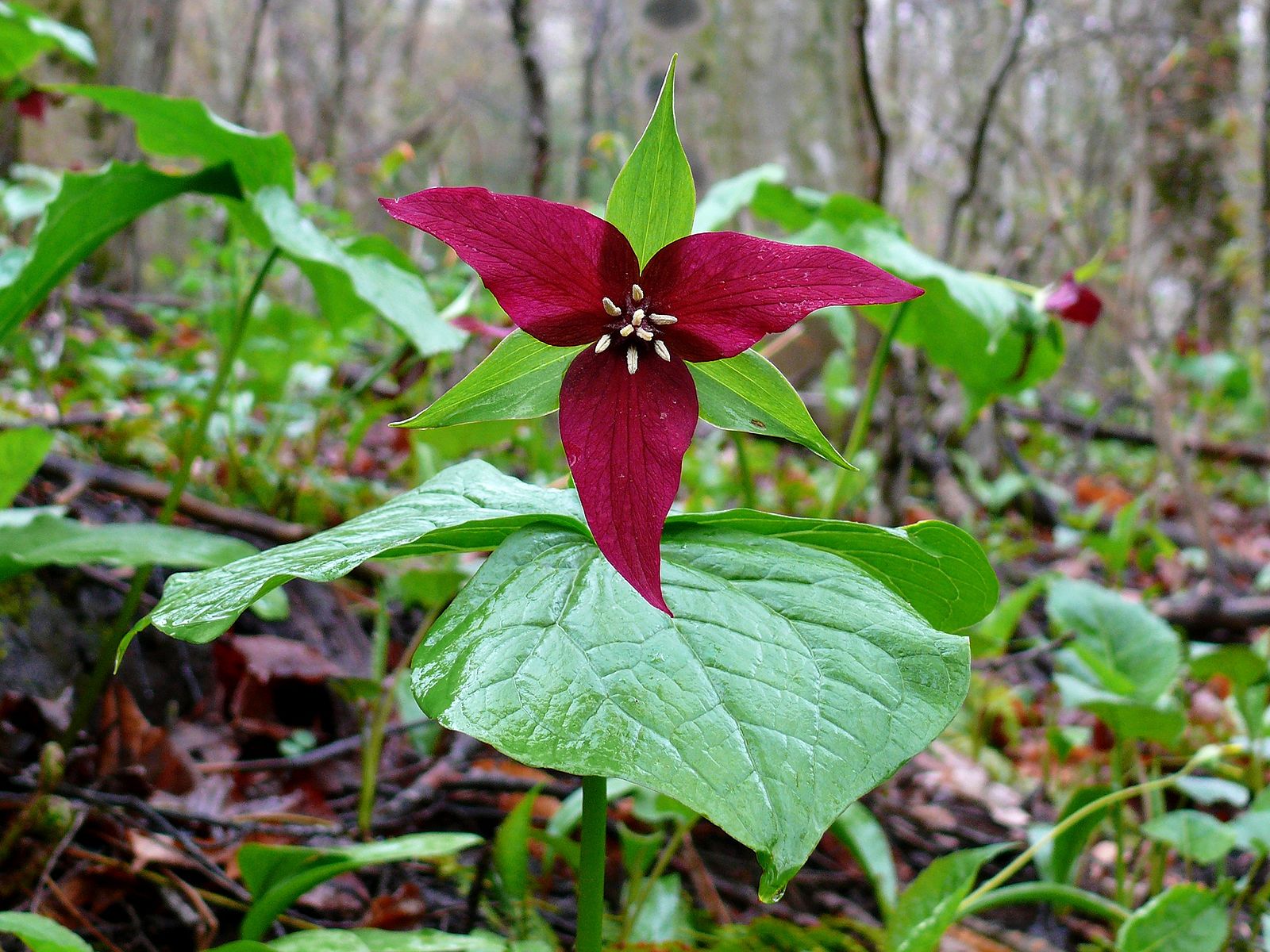 A red trillium is seen in the Southern Appalachians. It is often the target of poachers who aspire to place it in an ill-suited domestic ornamental garden. Courtesy Wiki Commons
A red trillium is seen in the Southern Appalachians. It is often the target of poachers who aspire to place it in an ill-suited domestic ornamental garden. Courtesy Wiki Commons
Forest service withholds ginseng permits to protect native Southern Appalachian plants as overall poaching persists
Paul Super has a message for people who take plants and animals from Great Smoky Mountains National Park:
It’s stealing.
“We’re trying to protect the park as a complete ecosystem and as a place that people can enjoy the wildlife and everything that lives here … but they have to do it in a sustainable way, and poaching doesn’t fit,” said Super, the park’s resource coordinator.
“Be a good citizen. Enjoy the park without damaging it.”
Super said the novel coronavirus pandemic led to the second-highest visitation to the park in 2020, just over 12 million, even with the park being closed briefly.
“This year will likely have the highest visitation ever,” he said, adding that the park is, in terms of the pandemic, a “relatively safe place for family and friends.”
Super said this higher visitation rate may lead to more poaching but it may also lead to more people who “appreciate something that a poacher would take away from them.
“Besides being illegal, that’s just selfish and rude,” Super said regarding plants and animals, and even cultural artifacts that are taken from the park.
Super is the park’s research coordinator, and is in charge of recruiting researchers to help better understand the nuances and full ramifications of stealing public natural resources. He said his researchers don’t enforce the laws, but they do alert law enforcement rangers to poaching incidents and suspicions.
- ginseng poaching
- poaching in great smoky mountains national park
- poaching in southern appalachia
- pink lady slipper
- ginseng
- smokies ginseng
- trillium
- great smoky mountains national park
- paul super
- smokies research coordinator paul super
- is removing plant from mountain illegal?
- insect poaching
- rare plant species
- ginseng trade
- butterfly poaching
- beetle poaching
- big south fork poaching
Park service seeks public input on regulation of Smokies helicopter flights
A public input session has begun as part of a joint effort between the Federal Aviation Administration and the National Park Service to establish limited helicopter tour routes over Great Smoky Mountains National Park along with protocols geared to reduce the environmental and visitor impact of the flights.
The flights are already occurring, and have been for years; park service officials said in a news release that 946 flights per year would be allowed under the Air Tour Management Plan, in line with current levels of helicopter tours conducted each year by two operators outside the park.
The park service and FAA plan a virtual public meeting on the proposed tour routes at 4:30 p.m. Sept. 16. Public comment is accepted through Oct. 3, and can be entered into the record at the Smokies Air Tour Management Plan website.
“Great Smoky Mountains National Park is among 24 parks of the National Park System developing air tour management plans in cooperation with the FAA,” park officials said in a press release.
“The agencies hope to complete all air tour management plans by the end of August 2022. The schedule is part of a plan approved by the U.S. Court of Appeals for the District of Columbia Circuit for the agencies to comply with the National Parks Air Tour Management Act of 2000 within two years.”
Black bear killed man whose body was found by Hazel Creek in Great Smoky Mountains National Park
Written by Thomas FraserRangers shot and killed bear eating body at campsite 82
(This story has been updated)
A black bear killed a man whose body was found by backpackers at a Hazel Creek campsite in September 2020.
Patrick Madura died “due to trauma caused by a bear,” according to a news release from Great Smoky Mountains National Park.
He would be only the second park visitor known to be killed in a bear attack in the 80-year history of the national park.
Glenda Bradley was killed in a predatory bear attack on the Little River trail in 2000. Two bears were shot and killed by park rangers after a Boy Scout troop came upon the incident. The animals, a sow and yearling, were eating and attempting to cache Bradley’s body when they were killed.
Madura’s body was found by backpackers arriving at campsite 82 on Sept. 11, 2020. They first noticed an empty tent, then saw a bear “scavenging” the victim’s body across the creek.
Rangers responding to the subsequent emergency call found a bear eating Madura’s body and shot and killed the animal. Hazel Creek Trail and the campsite were temporarily closed following the incident.
Madura, 43, of Elgin, Illinois was hiking and camping alone when he was attacked, according to the park service. No additional information about food storage issues or what may have precipitated the attack was immediately available from the park service.
Madura was an accomplished outdoorsman with a masters in biology and was trained as an EMT and firefighter, according to local reporting from the Chicago area following his death last year.
Fatal attacks are extremely rare, given the number of visitors to the national park, the most visited in the country. Nonfatal attacks, while still rare, are more common. A bear attacked a teenager as she slept in a hammock near the Maddron Bald trail in the Cosby area earlier this year; she was airlifted from the park with serious injuries but was expected to make a full recovery. The bear involved in that attack was euthanized as well.
Rangers urge visitors to be Bearwise, but regularly encounter improper interactions between bears and visitors, such as an incident this summer in which a woman was cited for feeding a bear peanut butter from a vehicle in Cades Cove.
More...
A nursing bear and her cubs share an intimate Great Smokies moment
Written by Rob HunterA window on ursine motherhood in Cades Cove
As I was descending a wooded hillside in the heart of Cades Cove on a June afternoon, a motionless black bulk caught my eye off to my left.
I turned my attention there, regarded the scene for a few moments, and realized the sprawling blur was a large sleeping bear. A few moments more of inspection revealed three cubs snoozing in the branches overhead.
Despite Covid slowdowns and shutdowns, Smokies draws $1B in 2020 revenue to neighboring communities
Written by Thomas Fraser A Knoxville man tries his hand at fly fishing in Abrams Creek during a family camping trip on the southwestern side of Great Smoky Mountains National Park. Thomas Fraser/Hellbender Press
A Knoxville man tries his hand at fly fishing in Abrams Creek during a family camping trip on the southwestern side of Great Smoky Mountains National Park. Thomas Fraser/Hellbender Press
Green begets green in Smokies region; Big South Fork and Cumberland Gap also economic players
Recent federal analysis of spending by national park visitors is a testament to the economic benefits of environmental protection, scientific study and outdoor recreation.
The 12.1 million visitors to Great Smoky Mountains National Park in 2020 spent $1.024 billion in neighboring communities in both Tennessee and North Carolina, according to a study released this week by the National Park Service. Similar, localized releases were distributed into national park communities across the country.
Closer to home, that number represents the estimated visitor money spent in areas that include traditional “gateway” communities, such as Townsend and Gatlinburg, and Cherokee and Bryson City in North Carolina. Regionally, it’s at least a $5 million increase since 2012. Travel problems, housing and employee shortages, overdevelopment and environmental destruction are of course persistent in some of those areas.
- great smoky mountains economic impact
- great smoky mountains national park visitation
- conservation area economic impact
- big south fork
- big south fork national river and recreation area
- economic benefit of wild area
- obed
- cumberland gap
- federal park visitation and spending
- national park service units in tennessee
- economic impact of national parks in tennessee
Bear attacks girl in Smokies backcountry campground; responding rangers shoot and kill aggressive bear
Written by Thomas FraserGirl in stable condition following attack; family followed all bear-safety protocols.
A bear attacked and injured a teenage girl as she slept in a hammock in a backcountry campground in the Cosby area of Great Smoky Mountains National Park.
The 16-year-old Middle Tennessee girl is in stable condition with multiple injuries following the attack at 12:30 a.m. Friday at backcountry site No. 29, according to a National Park Service release.
Her family was able to drive off the bear after the attack and contacted park emergency services; the girl was evacuated from the park by a Tennessee Army National Guard UH-60 Blackhawk helicopter to UT Medical Center at about 9 a.m. Friday. Hellbender Press has not pursued identification of the girl because she is a minor.
As responding rangers were at the campsite providing medical care in the wee hours of the morning, two bears approached and persisted in efforts to enter the campsite despite attempts to scare the bears away. Family members identified a particularly aggressive large, male bear as the one who attacked the girl, and rangers shot and killed the animal.
Forensic tests detected human blood on the dead bear.
Park officials said the campsite, along the Maddron Bald Trail on Otter Creek, will remain closed indefinitely.
The party of five was on a two-day camping trip, and the hammock was hanging near the rest of the family.
The group stored their food and packs on cables, per strict national park bear rules, according to the park service.
“While serious incidents with bears are rare, we remind visitors to remain vigilant while in the backcountry and to follow all precautions while hiking in bear country,” said Great Smoky Mountains Superintendent Cassius Cash in a press release. “The safety of visitors is our No. 1 priority.”
Here are some guidelines for bear safety in the Southern Appalachians and information on bears in Great Smoky Mountains National Park.
19-year-old woman killed after car veers into rock face on Smokies Spur
A car crash into rocks on the Gatlinburg-Pigeon Forge Spur killed a young woman and injured two others who were flown to UT hospital via medical helicopter.
Elizabeth Marie Parker, 19, of Centerville, Ohio, died when the sedan in which she was riding collided with a rock hillside on the right side of the road late Monday night, according to a release from the National Park Service.
Vehicle accidents are typically the No. 1 cause of fatalities each year in Great Smoky Mountains National Park, which attracts upwards of 12 million visitors annually.